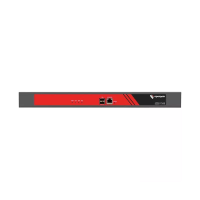Chapter 7: Alerts and Logging
164 Console Server & RIM Gateway User Manual
No authentication or encryption.
Authentication only. An authentication protocol (SHA or MD5)
and password will be required.
Uses both authentication and encryption. This is the highest level
of security and requires an encryption protocol (DES or AES) and
password in addition to the authentication protocol and
password.
o Complete the Username. This is the Security Name of the SNMPv3 user sending the message. This field is
mandatory and must be completed when configuring the console server for SNMPv3.
o An Authentication Protocol (SHA or MD5) and Authentication Password must be given for a Security
Level of either authNoPriv or authPriv. The password must contain at least 8 characters to be valid.
o A Privacy Protocol (DES or AES) must be specified for the authPriv level of security to be used as the
encryption algorithm. AES is recommended for stronger security. A password of at least 8 characters must be
provided for encryption to work.
Click Apply
Note Console servers with V3.0 firmware (and later) also embed the net-snmpd daemon which can accept SNMP
requests from remote SNMP management servers and provides information on serial port and device status (refer
Chapter 15.5 for more details).
Console servers with firmware earlier than V3.3 could only configure a Primary SNMP server from the
Management Console. Refer Chapter 15.5 for details on configuring the snmptrap daemon to send
traps/notifications to multiple remote SNMP servers.
7.5.4 Send Nagios Event alerts
To notify the central Nagios server of Alerts, NSCA must be enabled under System: Nagios and Nagios must be enabled
for each applicable host or port under Serial & Network: Network Hosts or Serial & Network: Serial Ports (refer
Chapter 10).
Note: In a CMS or VCMS centrally managed environment you can check the Nagios alert option. On the trigger
condition (for matched patterns, logins, power events and signal changes) an NSCA check "warning" result will be
sent to the central Nagios server. This condition is displayed on the Nagios status screen and triggers a
notification, which can then cause the Nagios central server itself to send out an email or an SMS, page, etc.
7.6 Logging
The console server can maintain log records of auto-response events and log records of all access and communications
events (with the console server and with the attached serial, network and power devices).
A log of all system activity is also maintained by default, as is a history of the status of any attached environmental
monitors.
7.6.1 Log storage
Before activating any Event, Serial, Network or UPS logging, you must specify where those logs are to be saved. These
records are stored off-server or in the ACM/IM gateway USB flash memory.
Select the Alerts & Logging: Port Log menu option and specify the Server Type to be used, and the details to
enable log server access

